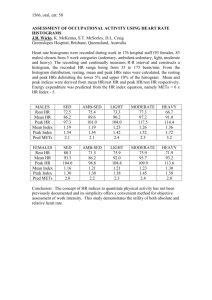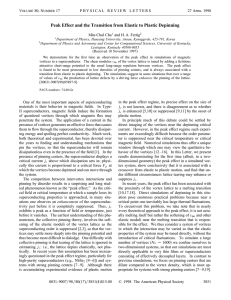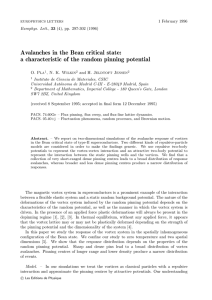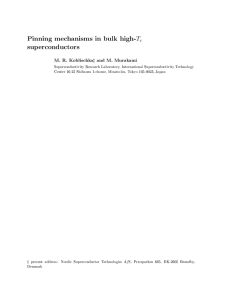Comment on “Peak Effect and the Transition from
advertisement
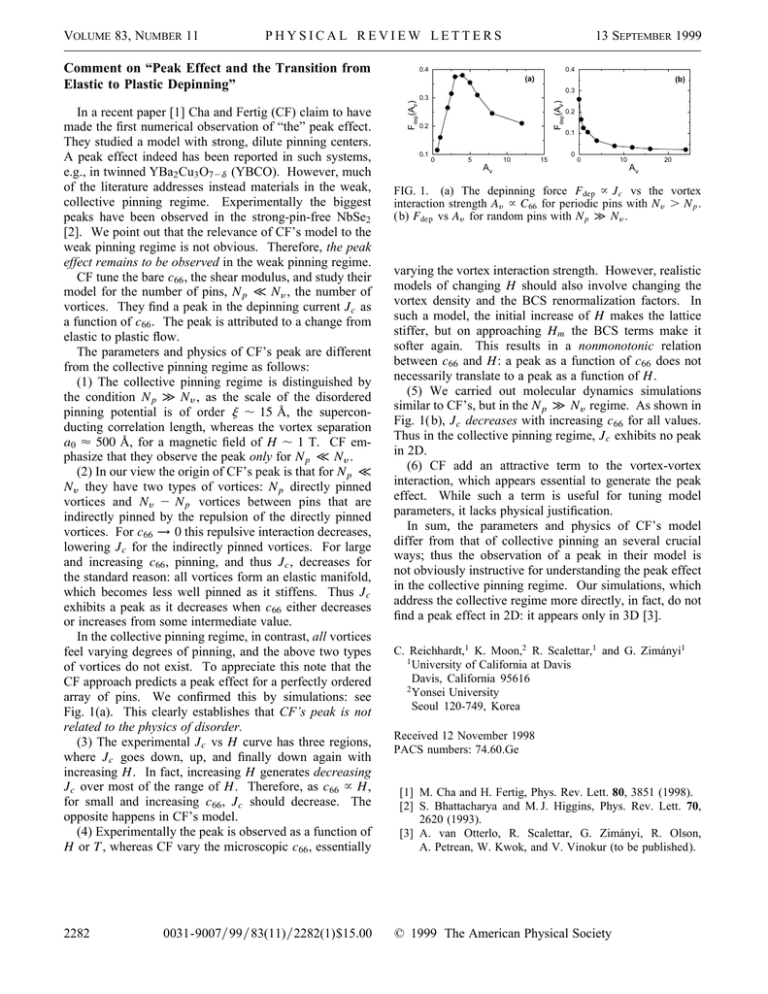
PHYSICAL REVIEW LETTERS Comment on “Peak Effect and the Transition from Elastic to Plastic Depinning” 2282 0031-9007兾99兾83(11)兾2282(1)$15.00 0.4 0.4 (a) (b) 0.3 Fdep(Av) In a recent paper [1] Cha and Fertig (CF) claim to have made the first numerical observation of “the” peak effect. They studied a model with strong, dilute pinning centers. A peak effect indeed has been reported in such systems, e.g., in twinned YBa2 Cu3 O72d (YBCO). However, much of the literature addresses instead materials in the weak, collective pinning regime. Experimentally the biggest peaks have been observed in the strong-pin-free NbSe2 [2]. We point out that the relevance of CF’s model to the weak pinning regime is not obvious. Therefore, the peak effect remains to be observed in the weak pinning regime. CF tune the bare c66 , the shear modulus, and study their model for the number of pins, Np ø Ny , the number of vortices. They find a peak in the depinning current Jc as a function of c66 . The peak is attributed to a change from elastic to plastic flow. The parameters and physics of CF’s peak are different from the collective pinning regime as follows: (1) The collective pinning regime is distinguished by the condition Np ¿ Ny , as the scale of the disordered pinning potential is of order j ⬃ 15 Å, the superconducting correlation length, whereas the vortex separation a0 艐 500 Å, for a magnetic field of H ⬃ 1 T. CF emphasize that they observe the peak only for Np ø Ny . (2) In our view the origin of CF’s peak is that for Np ø Ny they have two types of vortices: Np directly pinned vortices and Ny 2 Np vortices between pins that are indirectly pinned by the repulsion of the directly pinned vortices. For c66 ! 0 this repulsive interaction decreases, lowering Jc for the indirectly pinned vortices. For large and increasing c66 , pinning, and thus Jc , decreases for the standard reason: all vortices form an elastic manifold, which becomes less well pinned as it stiffens. Thus Jc exhibits a peak as it decreases when c66 either decreases or increases from some intermediate value. In the collective pinning regime, in contrast, all vortices feel varying degrees of pinning, and the above two types of vortices do not exist. To appreciate this note that the CF approach predicts a peak effect for a perfectly ordered array of pins. We confirmed this by simulations: see Fig. 1(a). This clearly establishes that CF’s peak is not related to the physics of disorder. (3) The experimental Jc vs H curve has three regions, where Jc goes down, up, and finally down again with increasing H. In fact, increasing H generates decreasing Jc over most of the range of H. Therefore, as c66 ~ H, for small and increasing c66 , Jc should decrease. The opposite happens in CF’s model. (4) Experimentally the peak is observed as a function of H or T , whereas CF vary the microscopic c66 , essentially 13 SEPTEMBER 1999 0.3 Fdep(Av) VOLUME 83, NUMBER 11 0.2 0.2 0.1 0.1 0 5 10 15 0 0 Av 10 20 Av FIG. 1. (a) The depinning force Fdep ~ Jc vs the vortex interaction strength Ay ~ C66 for periodic pins with Ny . Np . ( b) Fdep vs Ay for random pins with Np ¿ Ny . varying the vortex interaction strength. However, realistic models of changing H should also involve changing the vortex density and the BCS renormalization factors. In such a model, the initial increase of H makes the lattice stiffer, but on approaching Hm the BCS terms make it softer again. This results in a nonmonotonic relation between c66 and H: a peak as a function of c66 does not necessarily translate to a peak as a function of H. (5) We carried out molecular dynamics simulations similar to CF’s, but in the Np ¿ Ny regime. As shown in Fig. 1(b), Jc decreases with increasing c66 for all values. Thus in the collective pinning regime, Jc exhibits no peak in 2D. (6) CF add an attractive term to the vortex-vortex interaction, which appears essential to generate the peak effect. While such a term is useful for tuning model parameters, it lacks physical justification. In sum, the parameters and physics of CF’s model differ from that of collective pinning an several crucial ways; thus the observation of a peak in their model is not obviously instructive for understanding the peak effect in the collective pinning regime. Our simulations, which address the collective regime more directly, in fact, do not find a peak effect in 2D: it appears only in 3D [3]. C. Reichhardt,1 K. Moon,2 R. Scalettar,1 and G. Zimányi1 1 University of California at Davis Davis, California 95616 2 Yonsei University Seoul 120-749, Korea Received 12 November 1998 PACS numbers: 74.60.Ge [1] M. Cha and H. Fertig, Phys. Rev. Lett. 80, 3851 (1998). [2] S. Bhattacharya and M. J. Higgins, Phys. Rev. Lett. 70, 2620 (1993). [3] A. van Otterlo, R. Scalettar, G. Zimányi, R. Olson, A. Petrean, W. Kwok, and V. Vinokur (to be published). © 1999 The American Physical Society




